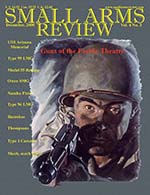Japan's Mass Produced Submachine Gun: The Type 100, Model of 1944
By Edwin F. Libby
The Japanese Type 100 submachine gun, Model of 1944, was manufactured by Nagoya Army Arsenal at its Torilimatsu Factory in Aichi-ken, Japan. More than 8300 guns of this model were made there in the latter part of 1944 and in 1945 until the Pacific War came to its conclusion in August of 1945. This weapon is readily identified by the markings at the top rear of the gun’s receiver, i.e., “100 Shiki, or “100 Type”; its crude construction and finish which includes many obvious welding seams and prominent tool marks on its metal parts; its non-adjustable, simple rear peep sight which is spot welded to the receiver; its compensator integral to the barrel casing at the muzzle; its bayonet lug welded beneath the barrel casing; by its pinned assembly of receiver and barrel components; and its wooden stock of two-piece construction, which is found often with a nailed-on wooden buttplate. This weapon is an unlocked, blowback submachine gun chambered for the Japanese 8mm Nambu pistol cartridge made for use in the Type 14 Nambu automatic service pistol which, in the Type 100 Model of 1944, delivered a 104 grain jacketed bullet at 1100 feet per second at the muzzle. In a U.S. Army training film which introduced the U.S. M2 carbine, the new carbine model was compared with the Type 100 Model of 1944 in a shooting demonstration wherein the submachine gun inappropriately was presented as a like weapon. Indeed, both weapons fired full-automatically, and both fired at about the same cyclic rate, but of course cartridge powers and ballistics were hardly comparable and this fact was shown to promote confidence in the new carbine.
In 1944, Japanese Army Ordnance recognized demands that came from infantry who had found the need for a submachine gun in the jungle fighting in the Southern Pacific Zone. Paratroop forces also needed a less complicated and more reliable weapon than the Type 100 submachine gun, Model of 1940, then in use. Given the pressing needs of the progress of the Pacific War at this time, the decision was made to direct all submachine gun development efforts towards improving the functioning and simplifying the construction of the 1940 Model Type 100 to prepare it for production en masse. In so doing, the costly and time-consuming machining of the 1940 model was dispensed with. A firing pin lock-out device on the breech bolt of the 1940 model was eliminated, and the removable barrel assembly became permanently fixed. A rear tangent sight was replaced with a welded-on sheet metal peep, and the hinged, folding stock of some 1940 model guns was replaced by a solid straight stock of two-piece wood construction. The stock had fixtures that allowed quick separation from the receiver and its components to facilitate convenient maintenance and cleaning. Production of the carefully finished thirty-round box magazine of the 1940 model was accelerated by redesigning the follower and magazine spring, and by finishing assembly welds only as necessary to assure proper fitting of the magazine to the magazine well. The product of these efforts, the Type 100 submachine gun, model of 1944, was crude in appearance but reliable in functioning and it delivered accurate fire within its intended range limitations at a cyclic rate of approximately 750 rounds per minute.
The relatively small number of Type 100 model of 1944 submachine guns manufactured during their brief production period undermined the Japanese Army’s intended purpose for general distribution of these weapons to Japanese infantry units, with the result that the larger portion of these guns were issued to Army parachute troops and to Special Attack (suicide) Units. U.S. Army forces encountered the Type 100 model of 1944 submachine- gun in use by the Japanese Third and Fourth Parachute Regiments of the Second Parachute Group that raided the Burauen Army Airfields and the San Pablo Airfield on Leyte in the Philippine Islands in November of 1944. It also made its appearance in the battles for Luzon. In May, 1945, ten members of the Japanese Special Attack Unit armed with Type 100 model of 1944 submachine guns, with explosives and other weapons, rushed out of their twin-engine “Sally” bomber that crashed landed at Yontan Airfield on Okinawa, and began tossing grenades and incendiaries into American aircraft parked along the runway. Before the last of these Special Attackers were killed two days later, these men had destroyed two Corsair fighter aircraft, four C-54 transports, one Privater, damaged twenty-six other aircraft, destroyed two fuel dumps with 70,000 gallons of gasoline, killed two Americans and wounded eighteen others. Given the proper application and in the hands of determined troops, the Type 100 model of 1944 submachine gun proved to be an effective weapon. Fortunately, this weapon was not put into the field by the Japanese in quantity to be of serious consequence in changing the outcome of any significant battles.
This article first appeared in Small Arms Review V4N3 (December 2000) |
| SUBSCRIBER COMMENT AREA |
Comments have not been generated for this article.







